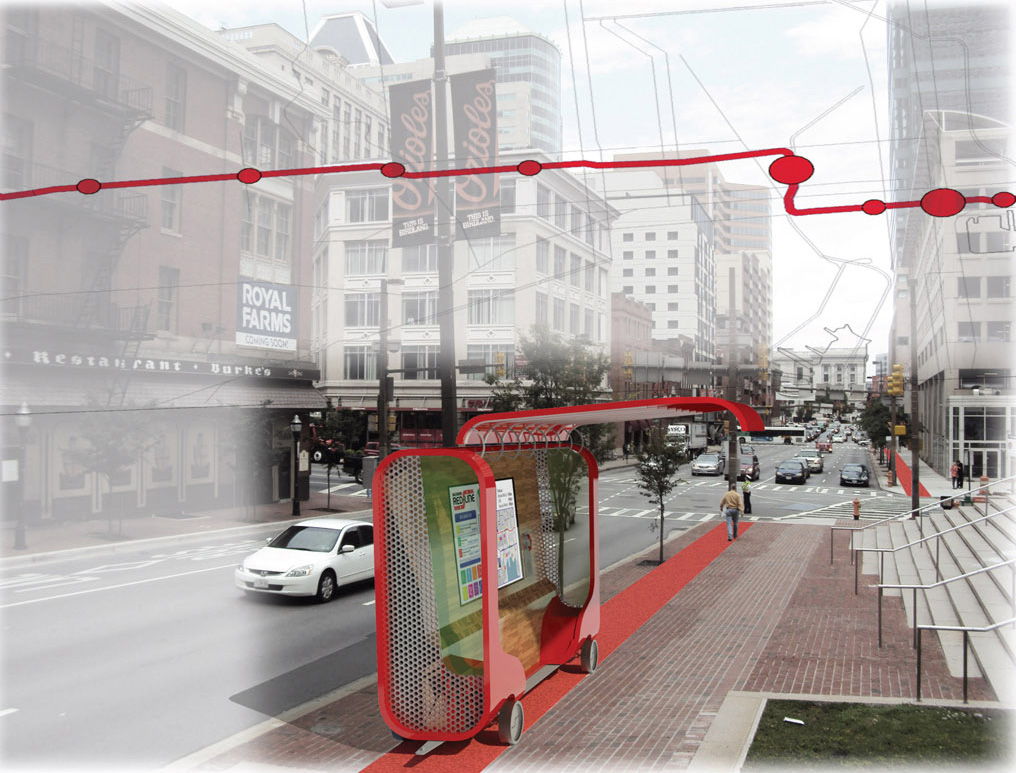
Open City Competition Entry Board
Open City Challenge
The Urbanite Project, 2011
Team Member
*Awarded 2nd Place* video link*Featured in the October 2011 issue of "Urbanite" magazine* link
*The Red Line Community Compact Annual Report 2011* link

Left: Urbanite Assistant Editor Rebecca Messner provides a synopsis of the six finalist entries at the Case[werks] gallery.
Right: The Red [Hot] Line team photo. Brian Frels, Thomas Wallof, David Dymond, Davin Hong, Gonzalo Rodriquez.
The Urbanite Project is a yearly competition sponsored by Baltimore's Urbanite magazine that seeks to encourage innovation in the city by bringing together people from different disciplines and viewpoints.
In 2011 The Urbanite Project asked teams to address quality-of-life issues brought about by the construction of the proposed Red Line, a east-west light rail transit line. The Red Line has the potential to not only alleviate traffic and provide all the usual public transit benefits, but also create connections between communities that have been traditionally disconnected. A drawback, commonly presented by the Red Lines vocal opponents, was the disruption of life within these communities caused by the construction. Common complaints included: noise, dust, traffic disruption, and limited pedestrian walkways.
The Urbanite Project sought to take advantage of the inevitable construction period to create unique, vibrant, productive urban space that would help to open up conduits of travel and communication along the route and leave a lasting positive impact on the city.
The RED [HOT] LINE
More so than any physical barrier, awareness is the key to mitigate the negative perceptions of construction occurring along the Red Line route. A simple iconic form combined with social-media technology can provide the information and communication in a fun and easily tangible manner that will keep the community positive during the temporary inconveniences that are necessary to build a better city.
Awareness of the coming Red Line will begin before construction through the full-scale mapping of the line as a form of public art. A physical red line of highly reflective traffic paint will be installed on streets and sidewalks mapping out the path and presence of the future Red Line as a way-finding tool.
Awareness of the coming Red Line will begin before construction through the full-scale mapping of the line as a form of public art. A physical red line of highly reflective traffic paint will be installed on streets and sidewalks mapping out the path and presence of the future Red Line as a way-finding tool.

Charles Center Station
The informational booth is to be located either adjacent to construction zones amongst conventional construction fences, trailers, and jersey walls or as a stand-alone destination on the red line route. The iconic form is reminiscent of a train car with Baltimore kitsch flare to be easily identifiable and understood within the community. The wheels and hinged front panel make for ease of storage and mobility as the booths are relocated along the red line, and the panel locks in the “up” position to create a canopy for the users. While the mobile kiosk is made of steel, an inherently recycled and recyclable material, its basis of sustainable design lies in its durability, flexibility, adaptability, and reusability. The back panel folds down forming a transaction table transforming the booth into a market stand to be used for events during Red Line construction and afterwards for local festivals such as Artscape and urban farmer’s markets.

Touch-screen information terminals
The hotline and touch-screen displays (located in select booths based on construction and community activity) are the heart of the Red (Hot) Line. The interactive terminals will provide easily accessible information on construction status timelines, Red Line facts, ecological and transit statistics, alternate routes during construction, local attractions and businesses, and a trip planning function. In addition, the graphic displays will afford business owners free advertisement space as compensation for blocked signage and disturbed street frontage during construction. Providing their logo or advertisement to the booth display also shows their patrons they support the city’s progress. The touch screen interface offers a “fun factor” which engages the community while also deterring vandalism. Competitive user statistics can be stored and displayed such as “who has the highest score in reducing their carbon footprint?”, or “who will save the most money on gas by using public transit?” Many functions of the display will also be available via the Red Line website which can be accessed from mobile devices using free WI-FI along the Red Line route. The direct hotline will provide open communication for citizens either directly or indirectly affected by or invested in the Red Line. The simple gesture of letting the public know “we’re available and we’re listening” is the key to a positive transition period during the Red Line’s enhancement to the city of Baltimore.




